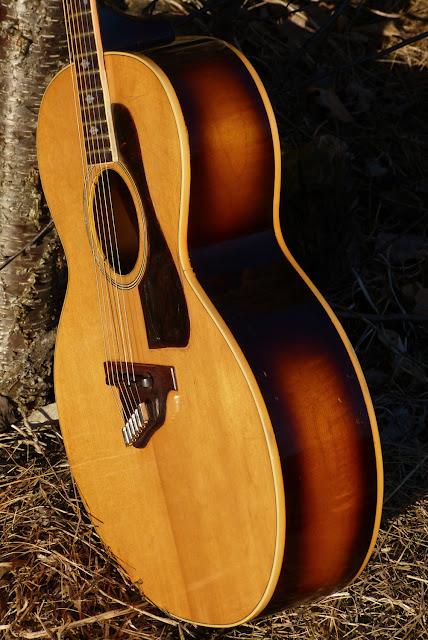1946 Gretsch-made Bacon Belmont Flattop Jumbo Guitar
Let's admit it, everyone -- my customers are so cool for sending such wild stuff my way! I've been wanting to play one of these strange old Gretsch flattops for some time and the fact that this is an off-brand Gretsch (with the Bacon branding) and a little earlier is just icing on that strawberry-frosted, lemon-delight cake.
There's a Gretsch-style serial number stamped in the headstock's top that's very faint and reads 147X where X is 1, 3, or 7 -- I can't tell. That places it probably around 1946-47, so I'm calling it a '46 and that makes a lot of sense considering the features and fittings. It's a full, jumbo-sized guitar with a 17" lower bout, 4 1/4" depth, and a very long 26 1/4" scale length. The neck is a 14-fret, fast, 1 11/16" nut job with a slim-to-medium, C-shaped profile on the rear. The string spacing is narrower at the nut and the board has a very-curvy ~9" radius, so the neck actually handles a bit like a round-C, 1 5/8" Fender neck from the 60s.
The top is solid spruce and ladder braced (three main braces on the lower bout -- one below the soundhole and the other two on shallow diagonals below it) while the back and sides are ply, very-flamed maple. It's a lightweight guitar and the weight savings are probably due to the all-ply, thin-wood build of the body (there's no bracing on the back as it's press-arched) and the unreinforced (but 5-piece laminated) neck.
The instrument is also all-original and, I'm not afraid to say, looks the business. It also plays like it looks, too, after work. My customer bought this, and despite mild protestations, had it sent here before going on to him overseas. I'm thoroughly glad he did have it stop by, as while it played alright (the action was close enough), the fretboard extension was "ski-jumped" a bit which was adding buzz up the neck, the adjusters on the archtop-style adjustable bridge had been removed to lower the action (and thus the back-angle on the saddle was almost non-existant), and a crack needed to be cleated and addressed near the pickguard on the top.
My work was, then, to give it a neck reset, fret level/dress, address the crack, and set it up. On the other side of repairs, the playability is "standard" with 1/16" DGBE and 3/32" EA at the 12th fret. The neck itself begins to backbow down towards the body from the 11th fret onwards, but only in a shallow dive which doesn't limit playability. Tone-wise, the thing has plenty of archtop-style cut and zing (almost in a crunchy/compressed gypsy-jazz sort of way), but still has enough warmth and creamy-topped sustain to play cowboy chords sufficiently. I like it -- it's weird!
It's also beautiful. No one does "odd-duck-cool" like Gretsch, ya know?
The embossed, two-color pearloid headstock veneer is pretty hip, too. The nut is bone and original.
The simple diamond-style pearl inlays in the rosewood fretboard recall earlier Gretsch banjo efforts of the 1930s.
I forgot to mention strings, too -- I have this strung with 52w, 40w, 30w, 22w, 15, 11 gauges. The long 26 1/4" scale means that, considering the speedy cut of the neck, one must be slightly careful with how much tension this is strung with. A regular Martin-style long scale (~25.4") with 12s would run about 165 lbs of tension while this set of 11s clocks-in at the same on its longer scale. If strung with 12s, this would jack the tension up to 175 lbs or so.
The bridge is the coolest bit, right? That's why I wanted to knock the neck back and get its functionality back. The metal holder for the strings is actually bolted through the bridge and into the inside with a couple of 1/4" nuts and washers.
The adjustable, archtop-style bridge makes action adjustments easy-peasy. Gretsch was clever in their design idea, too, in that the retainer for the strings actually slants "uphill" on the treble side. This reduces the break-angle on the treble side of the saddle and thus resists "knocking-over" the saddle with sideways tension.
The combination of a creamy-yellow "natural" top and sunburst sides and back looks really slick.
The flamed maple veneer on the back and sides is also really classy.
It's hard to see in the pictures, but the back of the headstock has a 1/8" maple veneer glued to it that "backstraps" onto the neck. I can't tell why Gretsch did this, but maybe the idea was to laminate the whole thing for strength.
The neck is a 5-piece affair with 3x maple sections and 2x something else -- rosewood? mahogany? It's alarming how modern the neck feels -- it's just slightly deeper than a "new" guitar's neck with maybe one of those retro "60s Gibson feel" profiles.
The original case came with it, too. There's a hinge that needs some work but, other than that and the usual musty old case smell, it's in good shape.























Comments